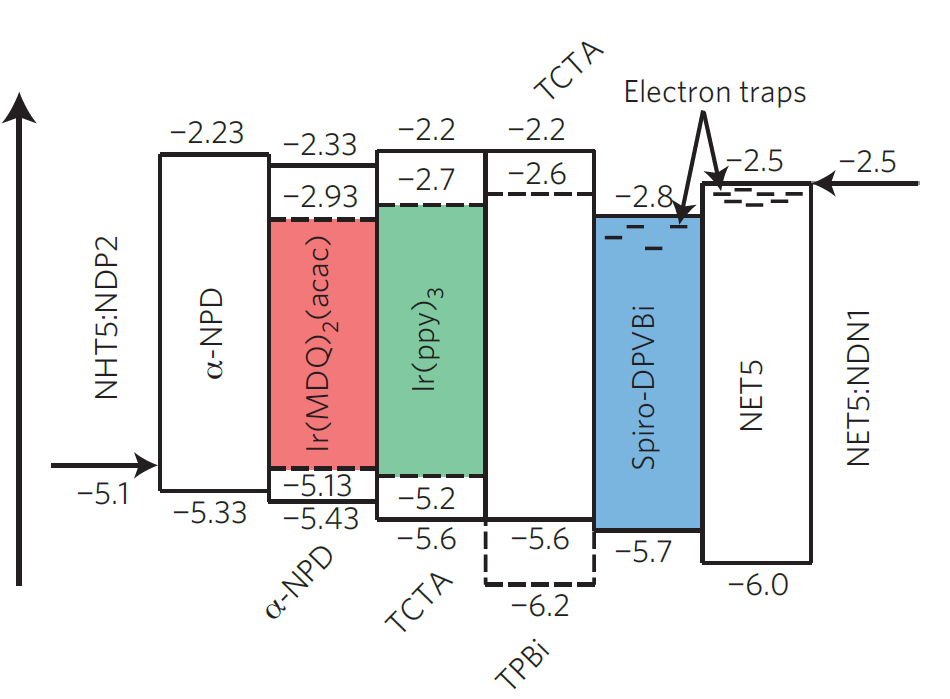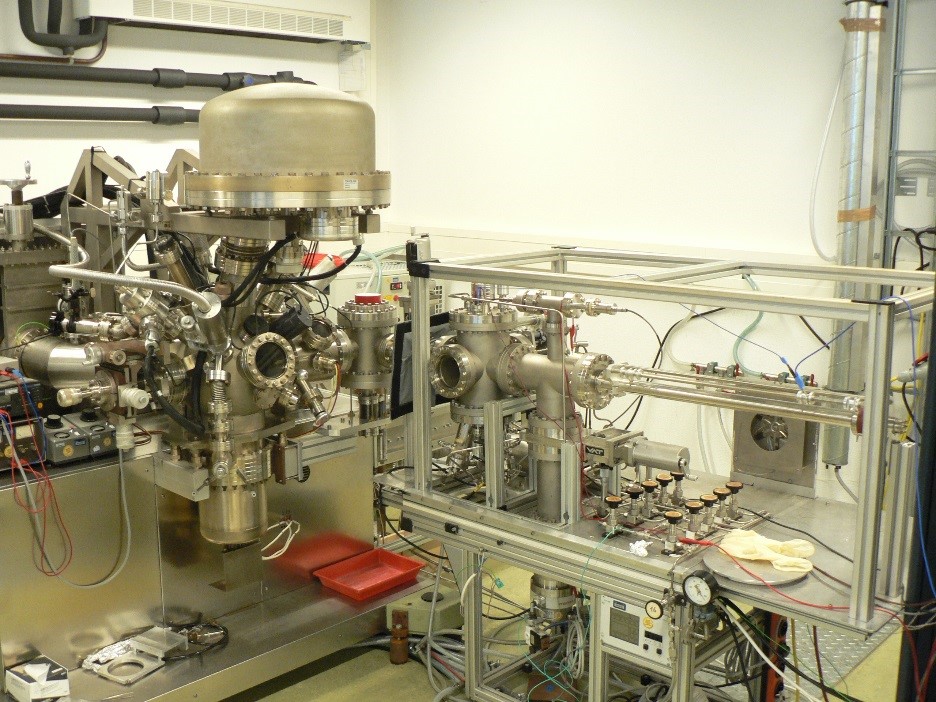Organic light-emitting diodes at M2N
Organic light-emitting diodes (OLEDs) are revolutionizing the display world, where they are quickly replacing displays based on LCD (liquid crystal display) technology. OLEDs may also replace inorganic LEDs in specific lighting applications. In OLEDs, use is made of the excellent luminescent properties of pi-conjugated organic molecules. Electrons and holes are injected from opposite electrodes into layers of such molecules. On the molecules where they meet, they form excitons (bound electron-hole pairs). These excitons decay radiatively to the ground state under emission of a photon. There are many interesting research questions related to the functioning of OLEDs, all directed at making them more efficient, longer-lived, less expensive, environmentally friendly, and suited for specific applications.


Left: OLEDs for displays. Right: OLEDs for lighting.
In the group M2N we perform experimental and theoretical research on OLEDs under the motto “from the molecule to the device”. Our aspiration is to understand and model fundamental physical aspects of the functioning of OLEDs, starting with the opto-electronic processes occurring at the molecular level and finally at the level of a device that works as desired. We collaborate closely with Simbeyond, a spin-off company of our group that sells simulation software to OLED device and materials manufacturers all over the world. Their main software product “Bumblebee” simulates the opto-electronic processes occurring in an OLED precisely as they really happen: electrons, holes, and excitons hop by phonon-assisted tunneling from one molecule to another (or from an electrode to a molecule and vice versa). At a molecule, an exciton can decay radiatively (desired) or non-radiatively (undesired), or interact with charges or other excitons (also undesired). Bumblebee is a kinetic Monte Carlo (kMC) tool where, following a Monte Carlo procedure, at each time step one of the possible processes is chosen for execution, exactly as it happens in the quantum world. In our group, we also use Bumblebee simulations intensively, as they help us to better analyze our experimental results

Energy diagram of a white OLED that we have investigated with kinetic Monte Carlo, displaying the hole (HOMO) and electron (LUMO) energies of a stack of organic layers. Every layer has a specific function. Red and green light are generated by phosphorescent triplet dyes in a host organic material, blue light by a fluorescent organic material
We are performing research on the following topics:
Triplet-triplet annihilation (TTA)
We optically excite organic layers consisting of a mixture of host and dye molecules with a laser pulse and analyze the photoluminescence (PL) decay transient. The laser generates excitons in the host, which quickly transfer to the dye. On the dye, the excitons should decay radiatively by emitting light with a specific color. The dye is a so-called “triplet emitter”, consisting of a heavy metal atom like Iridium surrounded by organic ligands. These dyes can be extremely efficient, because all excitons, both spin-singlet and triplet excitons, can in principle decay radiatively, due the spin-orbit coupling induced by the heavy metal atom. However, the lifetime of triplet excitons is rather long (~ms). This means that the excitons are vulnerable to quenching processes. One of these quenching processes is triplet-triplet annihilation (TTA), where two triplets interact and one of them is lost. TTA manifests itself as in a non-exponential PL transient. By analyzing and modeling the decay, we try to extract and understand the various processes leading to TTA.
Triplet-polaron quenching (TPQ)
In addition to TTA, triplet excitons can get lost by interactions with charges, electrons and holes. A charged plus the deformation of the molecule induced by the charge is a polaron, and we therefore speak of triplet-polaron quenching (TPQ). To systematically study TPQ, we make devices consisting of the organic layer to be studied, which is a mixture of host and dye molecules. Due to well-chosen electrode materials only one charge type is present in the device: electrons or holes. Excitons are generated in the same way as in our TTA-studies by a laser pulse. By analyzing and modeling the PL we try to extract the various processes leading to TPQ.
Beyond Marcus theory
It is our ambition to understand the rates of all electronic hop and exciton transfer processes using a proper quantum-mechanical description of these processes. In much previous work, these processes have been included using the semiclassical Marcus theory, within which the change of the molecular structure that happens when a molecule becomes charged or optically excited is described by just one parameter ("reorganization energy"). We find that we actually have to go beyond this theory, by taking into account all molecular vibrations involved in the hopping of a charge or an exciton in a fully quantum mechanical way. In particular, Marcus theory is unable to describe nuclear tunneling. The new approach we are developing properly takes this effect into account. We have also developed an efficient computational approach to find the hopping rate, which can then be used in kMC simulations. The effect leads, for example, to much higher exciton diffusivities than obtained with Marcus theory.
Thermally assisted delayed fluorescence (TADF)
The state-of-the-art in OLED technology is to use triplet emitters for efficient emission. There, the central idea is that the spin-orbit coupling of a heavy-metal atom induces intersystem crossing between singlet and triplet states. In triplet emitters, the emission comes about by phosphorescent decay of a triplet exciton. Despite the theoretically almost 100% efficiency, these emitters have various disadvantages (like an efficiency loss at large brightnesses due to TTA and TPQ, see above, but also the use of environmentally unfriendly metals). A quickly upcoming idea is to use emitters where the singlet exciton energy is just slightly above the triplet exciton energy. By thermal excitation, triplet excitons can then by reverse intersystem crossing convert into singlet excitons, which quickly decay radiatively by fluorescence. Hence the name “thermally assisted delayed fluorescence” (TADF). By using TADF emitters, the disadvantages of triplet emitters can be avoided. For example, these molecules do not need to contain have metal atoms. However, TADF brings along its own challenges, which are investigated by many groups across the world. In our group, we can study all the opto-electronics processes relevant to TADF with kMC simulations using Bumblebee, which provides a unique way to study TADF physics.
UPS analysis of energy levels in organic molecules
For an optimally functioning OLED, the energies of electrons and holes on the used molecules (the energies of the lowest unoccupied, LUMO, and highest occupied molecular orbital, HOMO, respectively) should be exactly right. The energies of holes in a specific organic molecule can in principle be measured by ultraviolet photoelectron spectroscopy (UPS), but the extraction of these energies from UPS spectra is non-trivial. The reasons are that (a) UPS is a surface-sensitive technique, whereas we want to know the energies inside a layer of the molecule, and (b) molecular vibrations are excited in a UPS experiment, which complicates the interpretation. In collaboration with the group of Baumeier at the Department of Mathematics and Computer Science we perform computations of the molecular energy levels as a function of depth in the disordered organic layer, taking into account the coupling of the charges to molecular vibrations. By comparing the computed spectra to the experiment spectra we can then extract the correct HOMO energies.
Extreme UV photolithography
In an opportunity to utilize or expertise on molecular materials and on advanced simulation methods to the research field in new application domains we are using kMC simulations to describe of higher-energy processes induced electron-hole cascades in metal-organic photoresist materials that are being developed for extreme UV (EUV) nanolithography. With these activities we aim at the development of molecular-scale models from which the ultimate resolution limits of EUV photolithography can be assessed.

Our photoelectron spectroscopy system.
Development of simulation tools
Together with our spin-off company Simbeyond, we are continually improving the kMC simulation tools and develop new, more approximate but also more efficient simulation tools. This development requires a balance between knowledge of quantum mechanical processes, device physics, mathematics, numerical procedures, and programming.
In all of the above areas we have regular openings for tailored Bachelor and Master projects. Much of our research is performed together with the spin-off company Simbeyond. We collaborate with groups all over Europe. Internationally, we mainly collaborate with groups in Asia. We are happy to discuss international internships.
Contact
Reinder Coehoorn (mostly experimental)
Peter Bobbert (mostly theoretical)